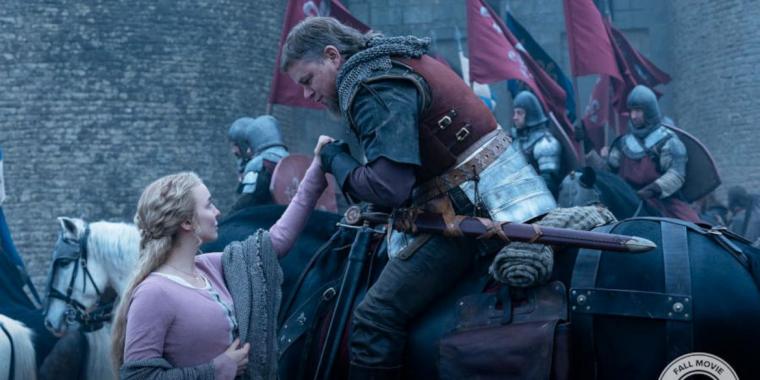
Jodie Comer and Matt Damon in The Last Duel
THE LAST DUEL
It's impossible to watch Ridley Scott's Medieval action drama The Last Duel without the #MeToo movement entering your mind. So I guess the movie could be considered a success, given that its director and unexpected trio of screenwriters all but demand our continued awareness of this period piece's sadly modern echoes every step of the way. Yet while Scott's latest is ultimately engrossing, if for deeply complicated and largely upsetting reasons, I couldn't help but find my thoughts also drifting away from #MeToo and toward a familiar fairy tale, as one third of the film is too hot, another third is too cold, and the final third is … . Well, it's not just right, but it certainly believes it's right.
Based on historical record and adapted from Eric Jager's celebrated nonfiction The Last Duel: A True Story of Trial by Combat in Medieval France, Scott's new swords-and-mud saga concerns a documented 1386 case in which the wife of a knight accused a squire – her husband's former friend and ally – of raping her. Demanding justice and the preservation of their honor (primarily his honor), the knight challenged the squire to a duel to the death, which the squire accepted despite his protestation that the stated crime was, in truth, a consensual tryst. There was, however, a huge, horrific caveat attached. If the knight won the battle and the squire was killed, the woman's claim would be validated – 14th-century proof of God's divine judgment. But if the knight was killed, it would be proof that his wife's accusation was a lie, and she would be burned alive for the falsehood. That's not quite what happened to, say, Christine Blasey Ford, but the parallels are kind of unmissable.
Consequently, what we're handed in The Last Duel is a 1386 take on a present-day “he said, she said” conundrum, with the “he said”s getting two-thirds of the two-and-a-half-hour running length. With each of the film's three distinct segments introduced via “The truth according to ...” title cards, we first see events unfurl through the perspective of the knight, Sir Jean de Carrouges (Matt Damon). That's followed by 50-ish minutes from the viewpoint of the squire, Jacques Le Gris (Adam Driver). And finally, “The truth according to Marguerite de Carroughes” – with the title card lingering on “the truth” as the other words fade away – gives us the purported actual events as experienced by the knight's spouse (Jodie Comer).
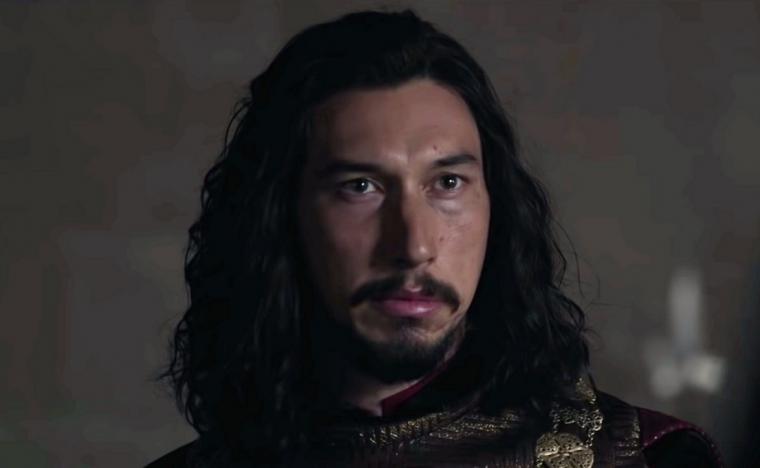
Even if the movie weren't designed with #MeToo at its forefront, there would be no question as to whose side we're meant to be on. Beyond the huffy, humorless Sir Jean and the loathsome, reptilian Jacques, all the men on screen are boorish, brutish, or worse, and the radiant Marguerite, with her blond tresses nearly as long as Rapunzel's, is a figure of abject goodness so down-to-earth that she even proves better than her husband at running the family finances. This is clearly narrative deck-stacking in the heroine's favor. Yet it's an undeniably effective strategy, and watching the film – and knowing history as we do – you can't say that Marguerite isn't deserving of our sympathy and trust. The problem, at least for me, comes in the knowledge of who, exactly, is stacking that deck. Which brings us back to the screenwriters.
For more than 20 years, Nicole Holefcener has been a true force of independent, female-centric cinema, her writing/directing credits boasting one winner after another: Walking & Talking, Lovely & Amazing, Please Give, Enough Said. (She also scored her only Academy Award nomination to date for co-writing the magnificent Melissa McCarthy vehicle Can You Ever Forgive Me?) Although none of the conversations in The Last Duel are particularly memorable, and the dialogue – perhaps intentionally – rarely sounds appropriate for the period, Holefcener would seem to be an ideal choice for lending this tale an updated, feminist sensibility. But while I don't know whether she was hired before, after, or alongside her credited collaborators, those scribes happen to be Matt Damon and Ben Affleck, reuniting as co-screenwriters for the first time, if you can believe it, since their 1997 Oscar winner Good Will Hunting. And here's where that pesky awareness of Real Life rears its ugly head.
If you're familiar with the Matt-and-Ben origin story, you know that the notorious (alleged) #MeToo monster Harvey Weinstein gave the boys their big breaks through the Miramax production company. You know that Damon and Affleck were subsequently tied to – or at least on publicly friendly terms with – Weinstein for the better part of two decades. You know that, after Weinstein's 2018 arrest at the height of the #MeToo movement, Damon and Affleck were frequently grilled in the press about their former boss' activities and behavior, with legit journalists and tabloid reporters alike asking variants on “What did you know and when did you know it?” And being cognizant of all that, I found it difficult to watch The Last Duel without seeing the film as a strange, distracting kind of historical correction, or perhaps apology, that routinely pulled me out of the movie: Damon and Affleck, with a female co-screenwriter's perceived blessing, telling #MeToo accusers (but really all women), “We may have worked for Weinstein, but we believe you – and we're going to show you how much.”
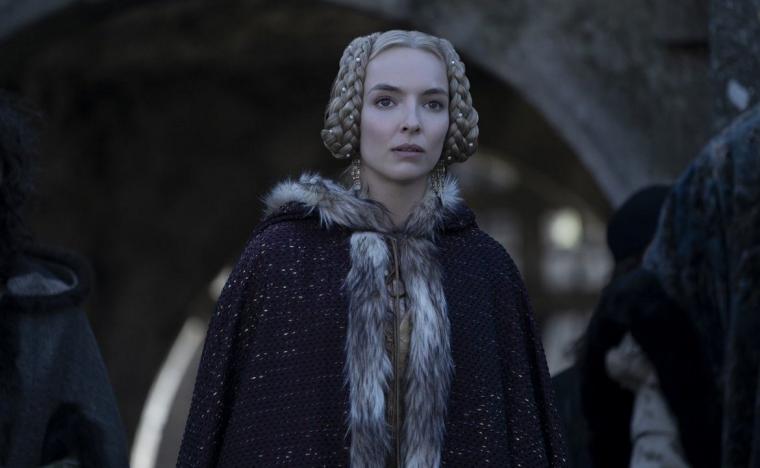
It's not just that Marguerite is entirely blameless in the film and that every man in sight is her moral lesser. We also get Damon playing her husband, a tantrum-prone bully who initially disbelieves his wife's charges and lashes out in incredulity and anger. We get Affleck playing Jacques' louche meal ticket Count Pierre, a libertine wretch who treats his wife and his subordinates the way one imagines Weinstein (again allegedly) treated his. We get Sir Jean's mother (a fabulously heartless Harriet Walter), upon learning of the rape accusation, telling Marguerite that she should recant her testimony and just accept sexual assault as a by-product of being in service to powerful men. In scene after scene, you're thrown out of the late-14th century and into a very specific period of the 21st, and that wouldn't be so problematic if there were anything else of dramatic import to latch onto. Unfortunately, though, and despite the film boasting Scott's traditional steel-gray handsomeness and production quality, its modern-day echoes – didn't Damon play Brett Kavanaugh on SNL? – are just about all the interest The Last Duel supplies.
Unlike Goldilocks' order of consumption, the first dish we get to taste here is the cold one, with Sir Jean's 50-minute “truth” an understandably expository but unnecessarily exhausting pastiche of wounded masculine ego, overly complex land negotiations, and the sorts of flashily edited, blood-spattering combat sequences that the helmer of Gladiator and Kingdom of Heaven and the 2010 Robin Hood can direct in his sleep. (On more than one occasion, he was practically directing them in my sleep.) Typically exciting actor that he is, Driver has alert and menacing moments during Jacques' recounting, but the debauchery, fiendishness, and blatancy are dialed up past 11; we don't need a final third of the movie to know that Jacques' version of events is absolutely not to be trusted.
Only in the Marguerite section, with Comer's devastatingly sincere and harrowing performance at its center, do the presentation's previous ice and fire converge for something that can pass as recognizably human – and even then, it's not the knight's wife but other, currently living humans whom our thoughts turn to. (I'd also argue that Scott's and the screenwriters' unequivocal labeling of Marguerite's version as the truth is disingenuous, at best, considering that the only two people who actually know what transpired between Marguerite and Jacques died more than 600 years ago.) Because it would have been relatively predictable for Scott and company to turn out another by-the-numbers Medieval battle pic with this Hundred Years' War offering, I give The Last Duel all the credit in the world for its comparative ambition. But while the results are somewhat enticing, this admittedly well-crafted movie remains oddly unsatisfying – a tale of the past too-awkwardly trapped in the present.
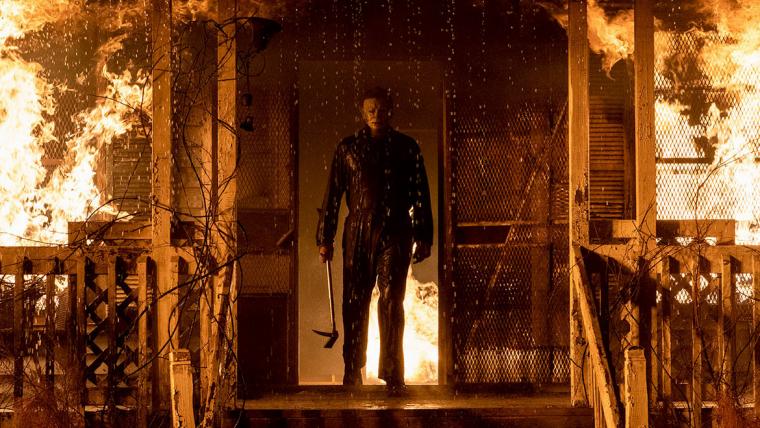
HALLOWEEN KILLS
Though the series would seem to fall right in my generational wheelhouse, I really can't stand the relentless, energy-drink obnoxiousness of Netflix's The Movies That Made Us, but I have watched a few episodes of this pop-culture piñata that focus on films I'm madly in love with. One of the more recent episodes covered John Carpenter's original Halloween from 1978, and amidst the aggressively snarky presentational comedy and rare moments of genuine insight, writer/director David Gordon Green shows up as an interviewee, and unwaveringly lauds Carpenter for creating a horror masterpiece that, for all of its violence, doesn't shed a single drop of blood. The irony of his compliment is almost too rich, given that Green's 2018 Halloween reboot and its new sequel Halloween Kills are among the bloodiest fright flicks of the past several years. This is part of why I hate The Movies That Made Us: It has almost zero interest in followup questions. If Green respects Carpenter's subtlety as much as he says, why didn't the interviewer ask him why Green's own Halloweens, by contrast, are so unremittingly gory? And so punishingly anti-subtle?
Obviousness blends with thunderous stupidity in Halloween Kills, which, I regret to inform you, is the second part in Green's planned 40-years-later trilogy that's scheduled to conclude in next year's Halloween Ends. With this latest entry the twelfth installment in a franchise overpopulated with underwhelming sequels, remakes, and reboots, I can only pray that the 2022 title is an accurate one. Taking place over the course of the long, long night that, at the end of the 2018 outing, saw Laurie Strode (Jamie Lee Curtis), her daughter Karen (Judy Greer), and her granddaughter Allyson (Andi Matichak) whisked off to the hospital, Green's latest is nothing but viscera-soaked wheel-spinning. The women mostly stay in the hospital (poor Jamie Lee actually never leaves it), and the unkillable Michael Myers continues his full-scale war on the population of Haddonfield, Illinois, with the victims this time including a friendly black couple, a sardonic gay couple, and a biracial pair of married senior citizens. Myers has grown so loathsome he's now murdering political correctness, too!
Even with a gun pressed to my head – or, more fittingly, a knife pressed to my abdomen – I'd be hard-pressed to cite which element of Green's sequel was its most inane, delighted though I was to see the return of character-actor great Charles Cyphers in his role as former sheriff Leigh Brackett. Maybe, for sheer awfulness, I should go with the support group of “Halloween survivors” who meet in a tacky karaoke bar and are led by Laurie's former babysitting charge Tommy (Anthony Michael Hall)? Perhaps the mob of incensed Haddonfield-ites who chant “Evil dies tonight!!!” ad nauseam and mistakenly terrorize and attack a portly schlub who stands a good foot shorter than the actual killer? How about Laurie's embarrassing, Loomis-like monologues about the unstoppable nature of evil? Or the 1978 flashbacks/recreations that continually interrupt whatever narrative momentum the film has going? Or no one in town even considering that the first place Michael might disappear to would be his childhood home and the original scene of his crimes? Or the fact that, as I may have mentioned, Jamie Lee Curtis never gets to leave the hospital?!? In the end, I suppose I'd rank Halloween Kills' finale as its absolute lowest ebb, given that the maddeningly incoherent editing doesn't allow you to even make basic sense of the ultra-violence you've just witnessed. (Or did you?) As we've learned repeatedly over four-decades-plus, Halloween entries can be many things: terrifying; silly; unnecessary; dull. Due to the franchise's remedially simple premise, I truly never expected to encounter one that had the gall to be confusing.
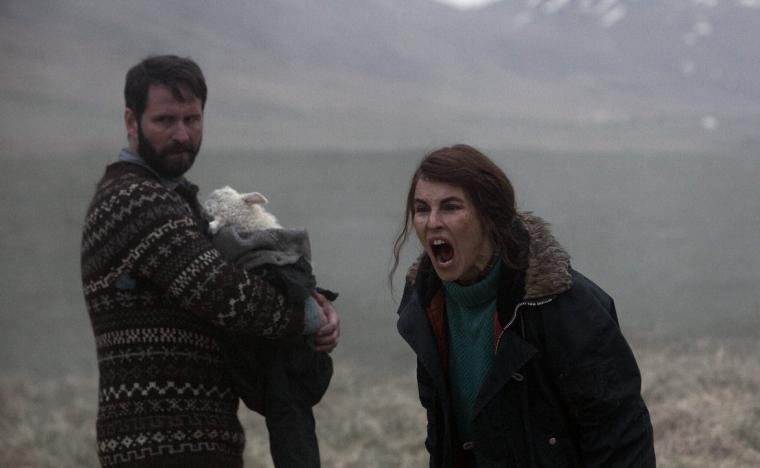
LAMB
As a holiday-themed antidote to the gaudiness and dopiness of Halloween Kills, allow me to instead recommend the slow-burn chills of Lamb, an Icelandic freakout by debuting writer/director Valdimar Jóhannsson. Imagine a more pastoral version of The Witch with nearly all the focus on a cuddly Black Phillip and you'll be in the general ballpark. In the film, Noomi Rapace and Hilmir Snær Guõnason play Maria and Ingvar, loving yet morosely childless farmers who discover, with only a minimum of shock and awe, that one of their sheep has birthed a baby with the head of a lamb and the body, mostly, of a human. Still mourning the death of their one child we know about, the couple consequently adopts the hybrid as their own and names her Ada, pulling their unused baby crib out of storage and eventually dressing the infant – who eventually learns to walk on two legs – in human attire. Things get complicated when the baby's mother begins bleating for her baby to be returned. Things get significantly more complicated when Ingvar's sketchy brother Pétur (Björn Hiynur Haraldsson) shows up and wants to know, as we all do: What. The. Eff. Is. Going. On. Here.
For long stretches in this deliberately paced yet mesmerizing work, you might easily mistake Lamb for a tender if unorthodox dysfunctional comedy in the Sundance vein, considering how happy the farmers are with their adopted/stolen creature and how seemingly contented she is with them. To do that, however, you have to ignore a plethora of warning signs: the nightmarish thumps and grunts of an unseen figure that precede the pregnancy; Pétur arriving near his brother's home in the trunk of someone's car; the relentless hounding of Ada's birth mother at the window of her child's bedroom. (I literally can't recall the last assemblage of screen animals that appeared this well-directed; the sheep are uniformly amazing, but even the family dog and cat appear to possess astoundingly expressive personalities.)
Although the film's tone is oftentimes genteel, even genial, Jóhannsson, co-screenwriter Sjón, and their actors land an intensely tricky balance between the perverse and the mundane, and when the movie's inevitable emotional and narrative climax hits, it's a powerful wallop – you've been so expertly manipulated into dreading the worst that a potentially laughable image emerges as downright mythical. I absolutely loved Lamb and am officially stoked for whatever weirdness Jóhannsson conjures next. And I can't possibly say enough about Ada, a conglomeration of actual animal, actual human, outstanding puppetry, and computer-generated visuals that suggest what David Lynch might have done in Eraserhead had 1970s technology been up-to-speed with his imagination. Ewe gotta see it.

THE RESCUE
Speaking as someone for whom drowning, tight spaces, and the possibility of dying while anesthetized are way high up on his list of phobias, I'm frankly astonished that I made it through The Rescue with my wits intact. Directed by Elizabeth Chai Vararhelyi and her husband Jimmy Chin, their documentary is about, um, a rescue, but a globally newsworthy one: the 2018 excavation of 12 teenage soccer players and their coach from the bowels of the Tham Luang caves in northern Thailand. You may not recognize their names, but Vararhelyi and Chin also gave us 2018's Free Solo, the Oscar-winning profile of noted rock climber Alex Honnold as he attempted to climb Yosemite National Park's El Capitan without the aid of harnesses or fellow climbers. I should maybe mention that vertiginous heights are also on my list of phobias. If the filmmakers' next project finds them confronting a swarm of angry bees, or being forced on-stage with lines only half-memorized, I swear I am not going.
I was positively thrilled, though, to see The Rescue, which lays out in agonizing, arresting detail everything that had to go right – and everything that might conceivably go wrong – for those 12 kids and their coach to be brought home safely. It's really the best kind of documentary, because even when you know in your heart that everything eventually turned out okay for the whole baker's dozen, you find yourself doubting your own memory based on the threat levels that continually escalate: so much rain, such an absence of food, so little time before the next monsoon season. (With cameras capturing much of the rescue unfurl – an effort that required the trapped soccer team to be unconscious as they were guided, one by one, underwater through narrow cave tunnels – I was never fully convinced that all those teens would survive.) Vararhelyi's and Chin's doc achievement is a spectacular procedural of unimaginable skill dovetailing with fantastic luck, and in describing everything from the cave's specific architecture to the Thais' wary welcome of outsiders to the makeshift rescue scenarios that were deemed the best of horrendous options, the interviewees are wonderfully lucid and moving. They're not the only ones who wind up crying at their recollections.
A stunning blend of found footage and newly recorded commentary that might easily leave you an emotional wreck (God bless those beautifully stalwart and even-keeled soccer players for not destroying us further), The Rescue just might net Vararhelyi and Chin Oscar number two. But I was saddened, after seeing the film, to land on several high-profile reviews that slightly damned the film for spending more time on the rescue process than the 13 individuals who suffered in the caves – an understandable reaction, but, it turns out, a pointless one. It seems, you see, that Netflix acquired the rights to the survivors' stories, while The Rescue's producers secured the rights to those who did the rescuing, so a full account of the saga couldn't be told without lawyers getting involved. Still, I'm trying to stay positive about this grossly mercenary transaction. After all, we know what most audiences adore even more than a moving, fascinating, legitimately inspirational tale of heroism and courage: a sequel.










